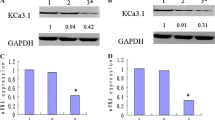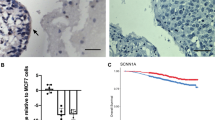Abstract
Background
Endometrial cancer is the most common gynecological cancer in developed countries. Potassium channels, which have many types, are suggested to play a major role in cancer progression. However, their role in endometrial cancer has not been fully investigated. We aimed to demonstrate whether the ATP-sensitive potassium channel blocker glibenclamide, voltage-sensitive potassium channel blocker 4-aminopyridine, non-selective (voltage-sensitive and calcium-activated) potassium channels blocker tetraethylammonium and potassium chloride (KCl) have any effect on the proliferation and migration of HEC1-A cells.
Methods and results
Proliferation and migration were evaluated by real-time cell analysis (xCELLigence system) and wound healing assays, respectively. Proliferation was reduced by glibenclamide (0.1 and 0.2 mM, P < 0.05 and P < 0.01, respectively), 4-aminopyridine (10 and 20 mM, P < 0.001) and tetraethylammonium (10 and 20 mM, P < 0.01 and P < 0.001, respectively). However, KCl did not change the proliferation. Migration was reduced by glibenclamide (0.01, 0.1 and 0.2 mM, P < 0.001, P < 0.001 and P < 0.01, respectively) and 4-aminopyridine (10 and 20 mM, P < 0.05 and P < 0.01, respectively). Tetraethylammonium did not change migration. However, KCl reduced it (10, 25 and 50 mM, P < 0.05, P < 0.01 and P < 0.01, respectively). Both proliferation and migration were reduced by glibenclamide and 4-aminopyridine. However, tetraethylammonium only reduced proliferation and KCl only reduced migration.
Conclusions
Potassium channels have an important role in HEC1-A cell proliferation and migration and potassium channel blockers needs to be further investigated for their therapeutic effect in endometrial cancer.





Similar content being viewed by others
References
Pecorelli S (2009) Revised FIGO staging for carcinoma of the vulva, cervix, and endometrium. Int J Gynaecol Obstet 105:103–104. https://doi.org/10.1016/j.ijgo.2009.02.012
Bray F, Ferlay J, Soerjomataram I, Siegel RL, Torre LA, Jemal A (2018) Global cancer statistics 2018: GLOBOCAN estimates of incidence and mortality worldwide for 36 cancers in 185 countries. CA Cancer J Clin 68(6):394–424. https://doi.org/10.3322/caac.21492
Felix AS, Weissfeld JL, Stone RA, Bowser R, Chivukula M, Edwards RP, Linkov F (2010) Factors associated with Type I and Type II endometrial cancer. Cancer Causes Control 21(11):1851–1856. https://doi.org/10.1007/s10552-010-9612-8
Evans T, Sany O, Pearmain P, Ganesan R, Blann A, Sundar S (2011) Differential trends in the rising incidence of endometrial cancer by type: data from a UK population-based registry from 1994 to 2006. Br J Cancer 104(9):1505–1510
Alexander SPH, Mathie A, Peters JA, Veale EL, Striessnig J, Kelly E, Armstrong JF, Faccenda E, Harding SD, Pawson AJ, Sharman JL, Southan C, Davies JA, Collaborators CGTP (2019) The concise guide to pharmacology 2019/20: ion channel. Br J Pharmacol 176(S1):142–228. https://doi.org/10.1111/bph.14749
Day ML, Pickering SJ, Johnson MH, Cook DI (1993) Cell-cycle control of a large-conductance K+ channel in mouse early embryos. Nature 65(6446):560–562. https://doi.org/10.1038/365560a0
Wonderlin WF, Woodfork KA, Strobl JS (1995) Changes in membrane potential during the progression of MCF-7 human mammary tumor cells through the cell cycle. J Cell Physiol 165(1):177–185. https://doi.org/10.1002/jcp.1041650121
Huang X, Dubuc AM, Hashizume R, Berg J, He Y, Chiang C, Cooper MK, Northcott PA, Taylor MD, Barnes MJ, Tihan T, Chen J, Hackett CS, Weiss WA, James CD, Rowitch DH, Shuman MA, Jan YN, Jan LY (2012) Voltage-gated potassium channel EAG2 controls mitotic entry and tumor growth in medulloblastoma via regulating cell volume dynamics. Genes Dev 26(16):1780–1796. https://doi.org/10.1101/gad.193789.112
Bi D, Toyama K, Lemaître V, Takai J, Fan F, Jenkins D, Wulff H, Gutterman D, Park F, Miura H (2013) The intermediate conductance calcium-activated potassium channel KCa3.1 regulates vascular smooth muscle cell proliferation via controlling calcium-dependent signaling. J Biol Chem 288(22):15843–15853. https://doi.org/10.1074/jbc.M112.427187
Monteith GR, Davis FM, Roberts-Thomson SJ (2012) Calcium channels and pumps in cancer: changes and consequences. J Biol Chem 287(38):31666–31673. https://doi.org/10.1074/jbc.R112.343061
Sun XX, Bostrom SL, Griffith LC (2009) Alternative splicing of the eag potassium channel gene in Drosophila generates a novel signal transduction scaffolding protein. Mol Cell Neurosci 40(3):338–343. https://doi.org/10.1016/j.mcn.2008.11.005
Innamaa A, Jackson L, Asher V, Van Shalkwyk G, Warren A, Hay D, Bali A, Sowter A, Khan R (2013) Expression and prognostic significance of the oncogenic K2P potassium channel KCNK9 (TASK-3) in ovarian carcinoma. Anticancer Res 33(4):1401–1408
Innamaa A, Jackson L, Asher V, Van Schalkwyk G, Warren A, Hay D, Bali A, Sowter A, Khan R (2013) Expression and effects of modulation of the K2P potassium channels TREK-1 (KCNK2) and TREK-2 (KCNK10) in the normal human ovary and epithelial ovarian cancer. Clin Transl Oncol 15(11):910–918. https://doi.org/10.1007/s12094-013-1022-4
Ousingsawat J, Spitzner M, Puntheeranurak S, Terracciano L, Tornillo L, Bubendorf L, Kunzelmann K, Schreiber R (2007) Expression of voltage-gated potassium channels in human and mouse colonic carcinoma. Clin Cancer Res 13(3):824–831. https://doi.org/10.1158/1078-0432.CCR-06-1940
Menéndez ST, Villaronga MÁ, Rodrigo JP, Álvarez-Teijeiro S, García-Carracedo D, Urdinguio RG, Fraga MF, Pardo LA, Viloria CG, Suárez C, García-Pedrero JM (2012) Frequent aberrant expression of the human ether à go–go (hEAG1) potassium channel in head and neck cancer: pathobiological mechanisms and clinical implications. J Mol Med (Berl) 90(10):1173–1184. https://doi.org/10.1007/s00109-012-0893-0
Venturini E, Leanza L, Azzolini M, Kadow S, Mattarei A, Weller M, Tabatabai G, Edwards MJ, Zoratti M, Paradisi C, Szabò I, Gulbins E, Becker KA (2017) Targeting the potassium channel Kv1.3 kills glioblastoma cells. Neurosignals 25(1):26–38. https://doi.org/10.1159/000480643
Ru Q, Li WL, Xiong Q, Chen L, Tian X, Li CY (2018) Voltage-gated potassium channel blocker 4-aminopyridine induces glioma cell apoptosis by reducing expression of microRNA-10b-5p. Mol Biol Cell 29(9):1125–1136. https://doi.org/10.1091/mbc.E17-02-0120
Ru Q, Tian X, Wu YX, Wu RH, Pi MS, Li CY (2013) Voltage-gated and ATP-sensitive K+ channels are associated with cell proliferation and tumorigenesis of human glioma. Oncol Rep 31(2):842–848. https://doi.org/10.3892/or.2013.2875
Freise C, Ruehl M, Seehofer D, Hoyer J, Somasundaram R (2013) The inhibitor of Ca2+-dependent K+ channels TRAM-34 blocks growth of hepatocellular carcinoma cells via downregulation of estrogen receptor alpha mRNA and nuclear factor-kappaB. Invest New Drugs 31(2):452–457. https://doi.org/10.1007/s10637-012-9879-6
Jäger H, Dreker T, Buck A, Giehl K, Gress T, Grissmer S (2004) Blockage of intermediate-conductance Ca2+-activated K+ channels inhibit human pancreatic cancer cell growth in vitro. Mol Pharmacol 65(3):630–638. https://doi.org/10.1124/mol.65.3.630
Schickling BM, England SK, Aykin-Burns N, Norian LA, Leslie KK, Frieden-Korovkina VP (2014) BKCa channel inhibitor modulates the tumorigenic ability of hormone-independent breast cancer cells via the Wnt pathway. Oncol Rep 33(2):533–538. https://doi.org/10.3892/or.2014.3617
Abdul M, Hoosein N (2002) Expression and activity of potassium ion channels in human prostate cancer. Cancer Lett 186(1):99–105. https://doi.org/10.1016/S0304-3835(02)00348-8
Wang ZH, Shen B, Yao HL, Jia YC, Ren J, Feng YJ, Wang YZ (2007) Blockage of intermediate-conductance-Ca2+-activated K+ channels inhibits progression of human endometrial cancer. Oncogene 26:5107–5114. https://doi.org/10.1038/sj.onc.1210308
Cherubini A, Taddei GL, Crociani O, Paglierani M, Buccoliero AM, Fontana L, Noci I, Borri P, Borrani E, Giachi M, Becchetti A, Rosati B, Wanke E, Olivotto M, Arcangeli A (2000) HERG potassium channels are more frequently expressed in human endometrial cancer as compared to non-cancerous endometrium. Br J Cancer 83(12):1722–1729. https://doi.org/10.1054/bjoc.2000.1497
Wang F, Chen Q, Huang G, Guo X, Li N, Li Y, Li B (2018) BKCa participates in E2 inducing endometrial adenocarcinoma by activating MEK/ERK pathway. BMC Cancer 18(1):1128. https://doi.org/10.1186/s12885-018-5027-9
Li N, Liu L, Li G, Xia M, Du C, Zheng Z (2018) The role of BKCa in endometrial cancer HEC-1-B cell proliferation and migration. Gene 655:42–47. https://doi.org/10.1016/j.gene.2018.02.055
Chin LS, Park CC, Zitnay KM, Sinha M, DiPatri AJ, Perillá P, Simard M (1997) 4-Aminopyridine causes apoptosis and blocks an outward rectifier K+ channel in malignant astrocytoma cell lines. J Neurosci Res 48(2):122–127. https://doi.org/10.1002/(SICI)1097-4547(19970415)48:2%3c122::AID-JNR4%3e3.0.CO;2-E
Woodfork KA, Wonderlin WF, Peterson VA, Strobl JS (1995) Inhibition of ATP-sensitive potassium channels causes reversible cell-cycle arrest of human breast cancer cells in tissue culture. J Cell Physiol 162(2):163–171. https://doi.org/10.1002/jcp.1041620202
Hendriks R, Morest DK, Kaczmarek LK (2000) Role in neuronal cell migration for high-threshold potassium currents in the chicken hindbrain. J Neurosci Res 58(6):805–814. https://doi.org/10.1002/(SICI)1097-4547(19991215)58:6%3c805::AID-JNR7%3e3.0.CO;2-V
Jombai T (2011) In vitro ınhibitory activity of black seed oil and potassium chloride against biomarkers of triple negative breast cancer. MSc University of Louisiana State, Baton Rouge, LA
Funding
This study was funded by Mersin University Scientific Research Projects Center (Grant Number: 2018-2-TP2-3023).
Author information
Authors and Affiliations
Contributions
IU, EEK, RNT conceived and designed research. EEK, RNT, KAH, IU conducted experiments. IU, EEK analyzed data. KAH and IU wrote the manuscript. All authors read and approved the manuscript.
Corresponding author
Ethics declarations
Conflict of interest
The authors have no relevant financial or non-financial interests to disclose.
Consent for publication
All authors consent to the publication of the manuscript in molecular biology reports.
Research involving human and/or animal participants
This article does not contain any studies with human participants or animals performed by any of the authors.
Additional information
Publisher's Note
Springer Nature remains neutral with regard to jurisdictional claims in published maps and institutional affiliations.
Rights and permissions
About this article
Cite this article
Erdem Kış, E., Tiftik, R.N., Al Hennawi, K. et al. The role of potassium channels in the proliferation and migration of endometrial adenocarcinoma HEC1-A cells. Mol Biol Rep 49, 7447–7454 (2022). https://doi.org/10.1007/s11033-022-07546-3
Received:
Accepted:
Published:
Issue Date:
DOI: https://doi.org/10.1007/s11033-022-07546-3




